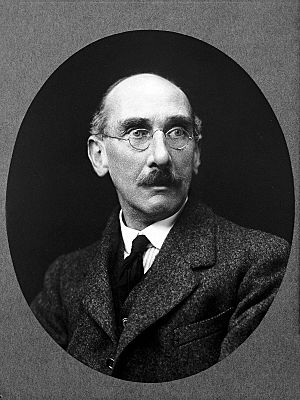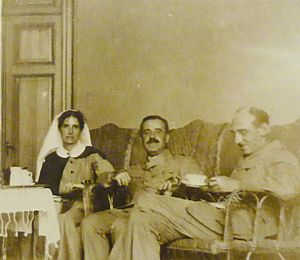Charles James Martin (physiologist) facts for kids
Quick facts for kids
Charles Martin
|
|
|---|---|
 |
|
| Born |
Charles James Martin
9 January 1866 |
| Died | 15 February 1955 (aged 89) |
| Awards |
|
| Scientific career | |
| Institutions |
|
Sir Charles James Martin (9 January 1866 – 15 February 1955) was a British scientist. He did important work on many different topics. These included toxins (poisons) from snakes and how our bodies control their temperature. He also studied serious diseases like plague, dysentery, and typhoid.
Sir Charles also researched nutrition and vitamin problems. He looked into proteins and even how to control rabbit populations using a disease called myxomatosis. From 1903 to 1930, he was the director of the Lister Institute of Preventive Medicine. This was a famous place for medical research.
Contents
Early Life and His Path to Science
Charles James Martin was born in Dalston, London, on January 9, 1866. He was the twelfth child in his family. As a child, he was often sick, so he went to a boarding school in Hastings.
When he was 15, Charles started working as a clerk in an insurance company. His father was an actuary there, which is someone who calculates risks for insurance. Charles was supposed to study math for this job. However, he found it quite boring.
One day, he found a chemistry book called "A Hundred Experiments in Chemistry for One Shilling." He tried out the experiments in the book. This made him very excited about science. He then convinced his father to let him study science. He took evening classes at King's College, London. Later, he studied medicine and physiology.
A Career in Research
In 1891, Charles Martin became a lecturer at Sydney University in Australia. He then moved to the University of Melbourne. He worked there as a professor of physiology for 12 years.
After his time in Australia, he returned to the UK. He became the first director of the Lister Institute of Preventive Medicine. This institute focused on preventing diseases.
In 1901, he was chosen as a Fellow of the Royal Society. This is a very high honor for scientists. It showed that he was a leading researcher. His work included studying snake venom and how toxins and antitoxins (things that fight toxins) work. He also researched how to separate different substances.
World War I and Later Work
During World War I, Charles Martin served as a pathologist. He worked with the Australian Army Medical Corps in places like Gallipoli and France. Pathologists study diseases. He discovered that some soldiers had paratyphoid fevers, not just typhoid. He then helped create a vaccine to protect against all three.
He also wrote an important guide on how to treat different types of dysentery. After the war, he went back to the Lister Institute. He retired from there in 1930.
Even after retiring, he continued his research. He spent two years in Australia. There, he led a team studying animal nutrition. When he returned to the UK, he set up a laboratory in his home in Cambridge. During World War II, this lab was used to keep animals for medical studies.
In 1934, he started studying the myxoma virus. This virus affects rabbits. He wanted to see if it could safely control large numbers of rabbits. He did experiments in Cambridge and on an island in Pembrokeshire. His work showed that the virus could indeed help control rabbit populations.
Awards and Recognition
Sir Charles Martin received many awards for his scientific work. In 1923, he was given the Royal Medal by the Royal Society. This is one of the most important science awards in the UK. He also gave the Croonian Lectures in 1930. In 1927, he was knighted, which means he was given the title "Sir."
His important contributions to science in Australia are still remembered. In 1951, a special fellowship was created in his name. It is called the Sir Charles James Martin Overseas Biomedical Fellowships.
Personal Life
Charles Martin married Edith Cross in 1891. They had one daughter. Edith passed away in 1954. Sir Charles Martin died in 1955 in Old Chesterton, Cambridge. He is buried there with his wife.


